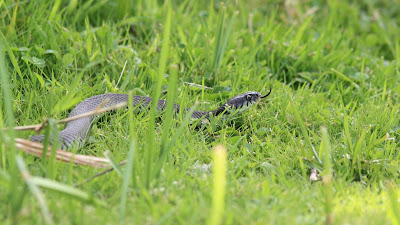Our accommodation was not very far from Wheatfen Broad, so there was little doubt that we would pay it a visit. Whilst it was now the wrong time of year for Swallowtails, we were hopeful of a different experience with a new cast of players. Wheatfen Broad is maintained by the Ted Ellis Trust, who are maintaining the habitat as the naturalist and broadcaster would have wished. In one of those interconnected, holistic moments that occur occasionally, we discovered that one of our friends in Orkney, Anne, used to visit Wheatfen as a small girl. Her mum was friends with Ted's wife, Phyllis, and as the ladies chatted and drank tea, Anne would mooch around, dabbling in the ponds with Ted, which I'm sure has played a large part in her lifelong enthusiasm for nature and wildlife-watching. And Ted would be very pleased, too.
Back to the present and, as soon as we set foot on a boardwalk, it was apparent that it was going to be a good day. There were butterflies and bees and hornets, a few wasps and distant glimpses of hawker and darter dragonflies. A Cetti's Warbler sang from the undergrowth and the harsh cackle of a Jay could be heard from nearby woodland.
I think it would be fair to say that Wheatfen is a gem of a place, what ever the time of year. Here are a few views from our balmy day in September:
But what of the wildlife?
Well...
Whilst I was photographing this spider (which, as a confirmed arachnophobe, I only appreciated for the sunlight catching its body), Our Lass was busy making an important (for us) discovery.
Firstly, the spider,
And, secondly, Our Lass's excellent powers of observation in spotting this...
A Willow Emerald damselfly, a 'lifer' for the pair of us. It is a species that is slowly spreading west, north and south in the UK, since colonising south east Suffolk as recently as 2007.
We walked around the nature reserve all morning, seeing no-one else save for the warden, and just kept encountering more and more wildlife. It was magical, although I know it isn't magic, it's about maintaining sufficient suitable habitat through sensitive management. But it felt like magic.
 |
| Common Darter |
 |
| Marsh Harrier |
 |
| Grass Snake |
 |
| Bumblebee species |
 |
| Migrant Hawker |
 |
| Hornet |
 |
| Brimstone butterfly |
 |
| Cricket on 5 (it had a leg missing) |
 |
| An impressively-large bracket fungus |






2 comments:
Greetings from Lincolnshire. Unbelievably in the middle of October Anisoptera and Zygoptera are flourishing! Yes Odanata are coping admirably but Lepidoptera are on the wane. Life is good. Regards, Mark.
Hi Mark, the rule of thumb for late season dragons is that they will survive until the first hard frost or fall of snow. If we have a mild Autumn, then it's possible a few would make it to December. Some butterflies over-Winter as adults, and these are likely to be making the most of the last of the warmth before finding a sheltered spot to hibernate.
Post a Comment